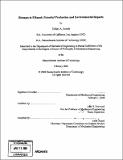Biomass to ethanol : potential production and environmental impacts
Author(s)
Groode, Tiffany Amber, 1979-
DownloadFull printable version (54.75Mb)
Other Contributors
Massachusetts Institute of Technology. Dept. of Mechanical Engineering.
Advisor
John B. Heywood.
Terms of use
Metadata
Show full item recordAbstract
This study models and assesses the current and future fossil fuel consumption and greenhouse gas impacts of ethanol produced from three feedstocks; corn grain, corn stover, and switchgrass. A life-cycle assessment approach with an integrated Monte Carlo uncertainty analysis is applied to each of these three bioethanol pathways. Incorporating a Monte Carlo uncertainty analysis within a life-cycle model enables one to account for system variability within the agricultural, technological, and geographic arenas. This results in a range of energy and greenhouse gas impacts rather than previous single-valued estimates. This uncertainty analysis brings greater clarity to the ethanol debate through evaluating the probability of previously published life-cycle assessment net energy results, from reports such as Farrell, Wang, Shapouri, and Pimentel. Lifecycle assessment net energy results show corn grain ethanol to have a positive value when DDGS coproducts are included within the assessment boundary and a slightly negative value when they are not. The system net energy value and GHG emissions are also sensitive to system input assumptions and geographic location. For lignocellulosic ethanol produced from corn stover and switchgrass, a positive net energy value and reduced GHG emissions are seen when compared to gasoline. In addition to net energy results and system GHG emissions, the petroleum displacement and land use impacts for an expanding and evolving ethanol industry are also evaluated.Corn grain, corn stover, and switchgrass-based ethanol potential production levels are also analyzed. It was determined that 55-65 billion liters per year of corn grain ethanol could potentially be produced in the next 10 years, consuming 30% of future US corn grain production. Corn stover and switchgrass have the potential to produce 25-35 and 10-20 billion liters per year of ethanol, respectively. (cont) These ethanol production results were then applied to assess the feasibility and environmental impact of achieving the new Renewable Fuels Standard, of producing 136 billion liters of renewable fuels by 2022. This study concluded that while the scale is potentially feasible from these three feedstocks, the timeline to achieve this scale would be very challenging given the cellulosic ethanol technological and economic advances that are still needed.
Description
Thesis (Ph. D.)--Massachusetts Institute of Technology, Dept. of Mechanical Engineering, 2008. Includes bibliographical references.
Date issued
2008Department
Massachusetts Institute of Technology. Department of Mechanical EngineeringPublisher
Massachusetts Institute of Technology
Keywords
Mechanical Engineering.